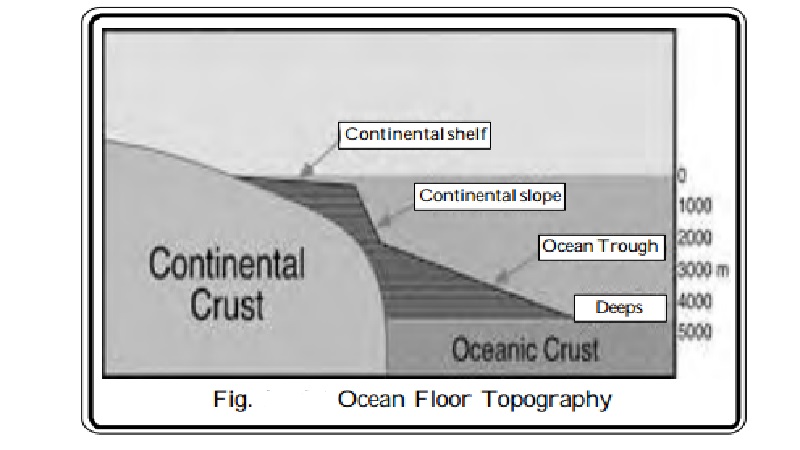Chapter: 11th 12th std standard Geography earth space Higher secondary school College Notes
Ocean Wave, The Currents : 4 currents of North Atlantic Ocean Gyre

The most important characteristic feature in that the ocean waters are always in a state of motion. The different kinds of motions are: waves, tides and currents.
Waves are up and down movements, caused by the action of winds on the water surfaces. Waves move in the direction of winds. When ocean levels rise and fall at regualr intervals during the course of the day. This is referred to as the tide. Tides are caused by the gravitational attraction between the moon and the Earth. The horizontal and vertical circulation of ocean waters creates currents. Major causes of ocean currents are wind, friction, gravity, and variations in water density in different parts of the oceans. These currents modify local climates. They distribute the heat energy form one latitude to another. Let us learn now about the circulation of ocean currents.
The Currents :
An ocean current can be defined as a horizontal movement of seawater at the ocean's surface. Ocean currents are driven by the circulation of wind above surface waters. Frictional stress at the interface between the ocean and the wind causes the water to move in the direction of the wind. Large ocean currents are a response of the atmosphere and ocean currents are responsible for the flow of energy from the tropics to polar regions. In some cases, currents are transient features and affect only a small area. Other ocean currents are essentially permanent and extend over large horizontal distances.
On a global scale, large ocean currents are constrained by the continental masses found bordering the three oceanic basins. Continental borders cause these currents to develop an almost closed circular pattern called a gyre. Each ocean basin has a large gyre located at approximately 30' North and South latitude in the subtropical regions. The currents in these gyres are driven by the atmospheric flow produced by the subtropical high pressure systems. Smaller gyres occur in the North Atlantic and Pacific Oceans centered at 50' North. Currents in these systems are propelled by the circulation produced by polar high pressure centers. In the Southern Hemisphere, these gyre systems do not develop because of the lack of constraining land masses.
A typical gyre displays four types of currents : Two east - west aligned currents found respectively at the top and bottom ends of the gyre; and two boundary currents oriented north - south and flowing parallel to the continental margins. Direction of flow within these currents is determined by the direction of the macro-scale wind circulation. Boundary currents play a role in redistributing global heat latitudinally. There are two gyres in the Northern Hemiphere and three in the southern Hemisphere.
Let us take North Atlantic Ocean Gyre as an example and undertstand the structure of a gyre. North Atlantic Ocean Gyre consists of 1. North Equatorial Current 2. Gulf Stream 3. North Atlantic Drift and 4) Canaries Current.
1. North Equatorial Current : The warm water adjacent to the Equator in the Atlantic Ocean is called the North Equatorial Current. This current forms mainly because of the easterly winds. These winds blow from the sub-tropical high pressure belt to the Equatorial low-pressure belt. These winds are also called Tradewinds. Tradewinds move the North Equatorial Current towards the west. In the West, the American continents obstruct the current and it is diverted to the North. This northwards - flowing current is known as the Gulf Stream.
2. Gulf Stream : The Gulf Stream flows along the eastern coast of Central and North America. It is a warm current as it carries the north Equatorial warm water. The direction of the warm Gulf Stream is influenced by the Westerly winds at higher latitude. These winds blow from sub-tropical high pressure areas to sub-polar low pressure areas. The Westerly winds move the Gulf Stream towards east across the North Atlantic Ocean. This Eastwards-flowing current is known as the North Atlantic Drift.
3. North Atlantic Drift : In the east, Europe and Africa act as barriers and the North Atlantic Drift branches off into two: 1. The Canaries Current and 2. The Iberian Current Among the two, the Canaries forms the fourth current in the North Atlantic gyre.
4. Canaries Current : In the east, the African continent obstructs the North Atlantic Drift, so it flows towards the south. This southwards-flowing current follows the west coast of African, and is called the Canaries Current. This is a cold current, as it carries cold waters from the North Pole. The Canaries Current flows towards the Equator. At the Equator, it flows as equatorial current and easterly winds once again push the waters towards the west. In the west, it becomes Gulf stream once again.
Of all the ocean currents the Gulf Current is a very strong warm current and the temperature is 25'C. This current protects England and Europe from severe cold. Otherwise, both the countries would suffer from a much colder climate like that of Canada, which is in the same latitude. But because of global warming there is a slight change in the direction of this current that has an impact on the local climates of England and Europe. But at gobal level, any modification in the circulation of the currents affects the natural climatic cycle. Let us understand this with an example of two currents in Pacific ocean as part of climatic cycles.
Related Topics